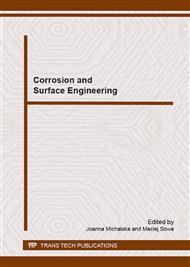p.325
p.329
p.333
p.337
p.341
p.345
p.349
p.353
p.357
The Impact of the Organic Form of Sulphur Originating from Coal on the Performance of Solid Oxide Fuel Cells
Abstract:
De-ashed coal samples involving from 0 to 0.6 %wt organic sulphur were investigated as solid fuels in a direct carbon solid oxide fuel cell (DC-SOFC). Prior to electrochemical investigations, the corrosion resistance of cell components in the coal bed was investigated at 900°C for 500h. X-ray photoelectron spectroscopy (XPS) analysis revealed the presence of sulphur on the surface of the yttria fully-stabilised zirconia (8 %mol Y2O3 in ZrO2, 8YSZ) as well as the surface of the Ni-8YSZ cermet anode following these tests. The electrochemical oxidation of coal on the surface of 8YSZ as well as that of the Ni-8YSZ cermet anode was investigated at a temperature range of 580–850°C. It was found that the presence of the organic form of sulphur as an impurity of coal caused a more rapid decrease in current during operation of a DC-SOFC with an 8YSZ electrolyte under load. The unfavourable impact of this form of sulphur on the electrochemical oxidation of coal on the Ni-8YSZ surface is more complicated than in the case of the 8YSZ electrolyte. In the DC-SOFC with Ni-8YSZ anode material, the presence of organic form of sulphur in de-ashed coal leads to depreciation of the Ni-8YSZ anode material.
Info:
Periodical:
Pages:
341-344
Citation:
Online since:
January 2015
Authors:
Price:
Сopyright:
© 2015 Trans Tech Publications Ltd. All Rights Reserved
Share:
Citation:


